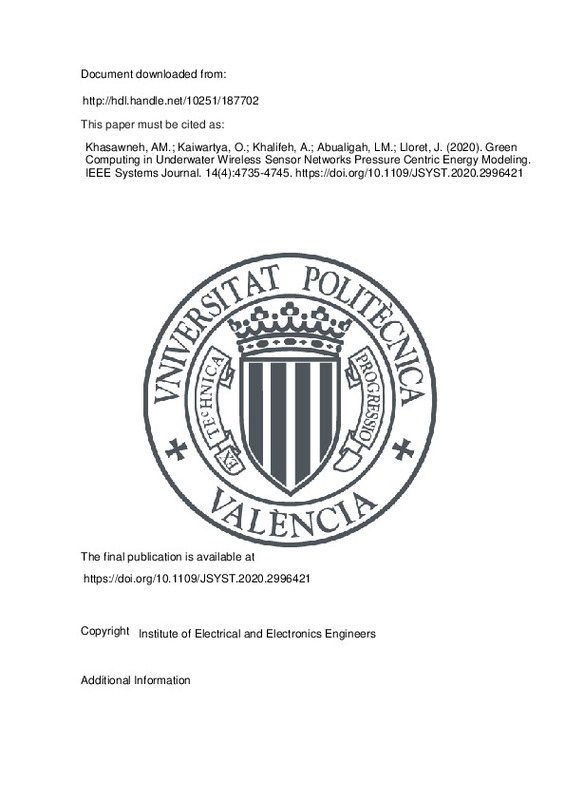JavaScript is disabled for your browser. Some features of this site may not work without it.
Buscar en RiuNet
Listar
Mi cuenta
Estadísticas
Ayuda RiuNet
Admin. UPV
Green Computing in Underwater Wireless Sensor Networks Pressure Centric Energy Modeling
Mostrar el registro sencillo del ítem
Ficheros en el ítem
| dc.contributor.author | Khasawneh, Ahmad M.
|
es_ES |
| dc.contributor.author | Kaiwartya, Omprakash
|
es_ES |
| dc.contributor.author | Khalifeh, Ala
|
es_ES |
| dc.contributor.author | Abualigah, Laith M.
|
es_ES |
| dc.contributor.author | Lloret, Jaime
|
es_ES |
| dc.date.accessioned | 2022-10-13T18:07:38Z | |
| dc.date.available | 2022-10-13T18:07:38Z | |
| dc.date.issued | 2020-12 | es_ES |
| dc.identifier.issn | 1932-8184 | es_ES |
| dc.identifier.uri | http://hdl.handle.net/10251/187702 | |
| dc.description.abstract | [EN] Underwater wireless sensor networks (UWSNs) have witnessed significant attention from both industries and academia in research and development. This is due to the wide range of applications including scientific, commercial, military, and environmental. Considering the peculiar characteristics and harsh environments of UWSNs, reliable green communication among sensor nodes in the network is one of the major challenging tasks. In this context, this article proposes a localization-free shortest path reliable and energy-efficient pressure-based routing (SPRE-PBR) protocol for UWSNs. SPRE-PBR considers three parameters including residual energy, pressure, and link quality for selecting the next forwarding nodes. Moreover, SPRE-PBR is designed and developed to control path selection and reduce the unnecessary forwarding based on route cost calculation and optimal shortest path algorithm. The comprehensive performance evaluation attests the benefit of SPRE-PBR as compared with the state-of-the-art techniques considering underwater networking centric metrics. | es_ES |
| dc.description.sponsorship | This work was supported by the the Amman Arab University, Jordan, and Nottingham Trent University, UK. | es_ES |
| dc.language | Inglés | es_ES |
| dc.publisher | Institute of Electrical and Electronics Engineers | es_ES |
| dc.relation.ispartof | IEEE Systems Journal | es_ES |
| dc.rights | Reserva de todos los derechos | es_ES |
| dc.subject | Routing | es_ES |
| dc.subject | Energy consumption | es_ES |
| dc.subject | Wireless sensor networks | es_ES |
| dc.subject | Reliability | es_ES |
| dc.subject | Routing protocols | es_ES |
| dc.subject | Acoustic waves | es_ES |
| dc.subject | Energy efficient | es_ES |
| dc.subject | Green computing | es_ES |
| dc.subject | Underwater wireless sensor network | es_ES |
| dc.subject.classification | INGENIERIA TELEMATICA | es_ES |
| dc.title | Green Computing in Underwater Wireless Sensor Networks Pressure Centric Energy Modeling | es_ES |
| dc.type | Artículo | es_ES |
| dc.identifier.doi | 10.1109/JSYST.2020.2996421 | es_ES |
| dc.rights.accessRights | Abierto | es_ES |
| dc.contributor.affiliation | Universitat Politècnica de València. Departamento de Comunicaciones - Departament de Comunicacions | es_ES |
| dc.description.bibliographicCitation | Khasawneh, AM.; Kaiwartya, O.; Khalifeh, A.; Abualigah, LM.; Lloret, J. (2020). Green Computing in Underwater Wireless Sensor Networks Pressure Centric Energy Modeling. IEEE Systems Journal. 14(4):4735-4745. https://doi.org/10.1109/JSYST.2020.2996421 | es_ES |
| dc.description.accrualMethod | S | es_ES |
| dc.relation.publisherversion | https://doi.org/10.1109/JSYST.2020.2996421 | es_ES |
| dc.description.upvformatpinicio | 4735 | es_ES |
| dc.description.upvformatpfin | 4745 | es_ES |
| dc.type.version | info:eu-repo/semantics/publishedVersion | es_ES |
| dc.description.volume | 14 | es_ES |
| dc.description.issue | 4 | es_ES |
| dc.relation.pasarela | S\473164 | es_ES |







![[Cerrado]](/themes/UPV/images/candado.png)

